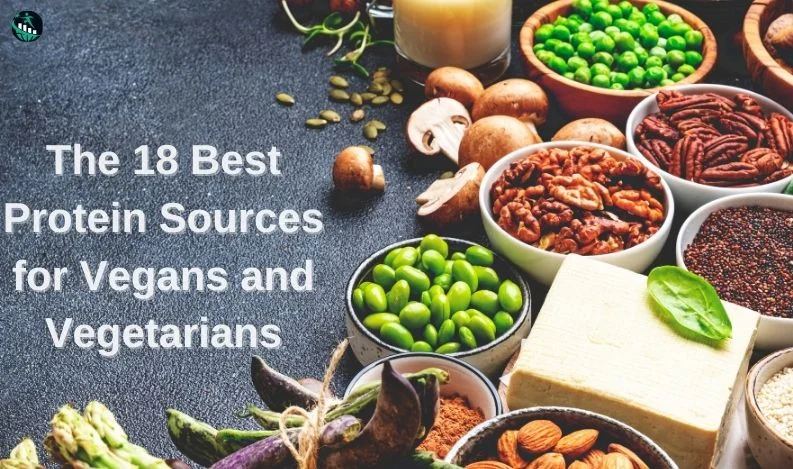
The 18 Best Protein Sources for Vegans and Vegetarians
Embarking on a vegan or vegetarian lifestyle brings numerous health benefits, including a lower risk of chronic diseases, better weight management, and a positive impact on the environment. However, one of the primary concerns when adopting a plant-based diet is getting enough protein. Protein is crucial for muscle repair, hormone production, and overall health. Fortunately, there are ample plant-based protein sources to meet your nutritional needs. Here’s a deep dive into the 18 best protein sources for vegans and vegetarians.
1. Seitan
Nutritional Benefits: High in protein, with about 25g per 100g serving. It's also a source of selenium and small amounts of iron, calcium, and phosphorus.
Culinary Uses: Seitan can be grilled, fried, or simmered. It's often used in vegan versions of familiar meat dishes like burgers, sausages, and stews.
Tips: Enhance its flavor by marinating before cooking. However, it's not suitable for those with gluten sensitivities.
2. Tofu, Tempeh, and Edamame
Nutritional Benefits: All are complete proteins containing all essential amino acids. They're also rich in iron and calcium.
Culinary Uses: Tofu is incredibly versatile, used in everything from scrambles to desserts. Tempeh works well in stir-fries and as a meat substitute in sandwiches. Edamame makes a great snack or salad topping.
Tips: Pressing tofu before cooking can improve its texture. Marinate tempeh for extra flavor.
3. Lentils
Nutritional Benefits: Provide 18g of protein per cooked cup. High in fiber, folate, and manganese, beneficial for heart health and digestion.
Culinary Uses: Lentils are great in soups, salads, and as a meat substitute in tacos or bolognese.
Tips: No pre-soaking is required, making them a quick and convenient protein source.
4. Beans and Chickpeas
Nutritional Benefits: Around 15g of protein per cooked cup, along with fiber, iron, and folate.
Culinary Uses: Beans can be used in chili, soups, and salads. Chickpeas are excellent in hummus, curries, and roasted as a crunchy snack.
Tips: Rinse canned beans to reduce sodium content.
5. Nutritional Yeast
Nutritional Benefits: A complete protein with 8g per 30g serving. Often fortified with B vitamins, including B12.
Culinary Uses: Adds a cheesy flavor to popcorn, pasta, and salads.
Tips: Look for fortified versions to help meet your vitamin B12 needs.
6. Spelt and Teff
Nutritional Benefits: Both are ancient grains high in protein (10-11g per cooked cup) and rich in iron, magnesium, and phosphorus.
Culinary Uses: Spelt can be used in bread and pasta. Teff is great for porridge and baking.
Tips: Teff is naturally gluten-free, suitable for those with gluten intolerance.
7. Hemp Seeds
Nutritional Benefits: Contain 9g of protein per 30g serving, along with omega-3 and omega-6 fatty acids.
Culinary Uses: Can be sprinkled on salads, blended into smoothies, or added to baked goods.
Tips: Store hemp seeds in the refrigerator to keep them fresh.
8. Green Peas
Nutritional Benefits: Nearly 9g of protein per cooked cup. High in vitamins C and K, and fiber.
Culinary Uses: Perfect in soups, curries, or as a side dish.
Tips: Fresh peas have the best taste but frozen peas are a convenient and equally nutritious option.
9. Spirulina
Nutritional Benefits: Offers 8g of complete protein per 2 tablespoons, along with a significant amount of iron and copper.
Culinary Uses: Can be added to smoothies, juices, or sprinkled on salads for a nutritional boost.
Tips: Start with small amounts to get used to its strong flavor.
10. Quinoa and Amaranth
Nutritional Benefits: Both are complete proteins, with 8-9g of protein per cooked cup. They're also high in fiber and iron.
Culinary Uses: Use in place of rice, add to salads, or use as a base for breakfast bowls.
Tips: Rinse quinoa before cooking to remove its bitter outer coating.
11. Ezekiel Bread and Other Breads from Sprouted Grains
Nutritional Benefits: Higher in protein and nutrients compared to regular bread, with about 8g of protein per two slices.
Culinary Uses: A healthier option for sandwiches and toast.
Tips: Look for breads made with a variety of sprouted grains to maximize nutritional benefits.
12. Soy Milk
Nutritional Benefits: Contains about 7g of protein per cup and is often fortified with vitamins and minerals, including vitamin D and calcium.
Culinary Uses: Can be used in cereal, coffee, and smoothies, or drunk on its own.
Tips: Choose unsweetened varieties to avoid added sugars.
13. Oats and Oatmeal
Nutritional Benefits: Offers around 5g of protein per half-cup serving of dry oats, along with fiber and magnesium.
Culinary Uses: Great for breakfast porridge, overnight oats, or added to baked goods.
Tips: Opt for whole oats for maximum health benefits.
14. Wild Rice
Nutritional Benefits: Provides nearly 7g of protein per cooked cup, along with fiber, vitamins, and minerals.
Culinary Uses: Can be used as a side dish or added to soups and salads.
Tips: Takes longer to cook than white rice, but its nutty flavor and texture are worth it.
15. Chia Seeds
Nutritional Benefits: Packed with 5g of protein per ounce, along with omega-3 fatty acids and fiber.
Culinary Uses: Can be used to make chia pudding, added to smoothies, or as an egg substitute in baking.
Tips: Soak chia seeds in liquid to form a gel-like consistency before consuming.
16. Nuts and Nut Butters
Nutritional Benefits: A source of protein, healthy fats, and various vitamins and minerals. Protein content varies by nut type.
Culinary Uses: Can be eaten as a snack, spread on toast, or used in baking and cooking.
Tips: Choose raw or dry-roasted nuts without added oils or salts.
17. Protein-rich Fruits and Vegetables
Nutritional Benefits: Certain veggies and fruits contain more protein than others, offering additional nutritional benefits like fiber, vitamins, and minerals.
Culinary Uses: Incorporate them into meals as sides, in salads, or as part of main dishes.
Tips: Aim for a variety to ensure a broad intake of nutrients.
18. Mycoprotein
Nutritional Benefits: Contains about 15-16g of protein per 100g serving. A source of fiber and nutrients with a meat-like texture.
Culinary Uses: Used in meat substitutes like burgers, sausages, and more.
Tips: Check labels for added ingredients if you have allergies or follow a strict vegan diet.
In conclusion, adopting a vegan or vegetarian diet doesn't mean compromising on protein intake. The 18 plant-based protein sources outlined offer a rich variety of options that cater to different tastes, dietary needs, and culinary preferences. From the meaty texture of seitan and the versatility of tofu, tempeh, and edamame, to the heartiness of lentils and beans, and the unique nutritional profiles of ancient grains, nuts, and seeds—there's something for everyone.
Incorporating these proteins into your diet can not only meet and exceed your daily protein requirements but also introduce an array of other essential nutrients, including fiber, vitamins, and minerals crucial for overall health and well-being. Moreover, exploring these diverse protein sources can inspire creativity in the kitchen, leading to delicious and nutritious meals that support a healthy, sustainable lifestyle.
Remember, the key to a balanced diet—whether vegan, vegetarian, or omnivorous—is variety. By mixing and matching these protein sources, you can ensure a comprehensive intake of all necessary nutrients, making your plant-based journey both enjoyable and fulfilling. So, embrace the abundance of plant-based proteins available, experiment with new recipes, and enjoy the health benefits of a diet rich in whole, nutritious foods.
Also Read:-








Recent Comments: